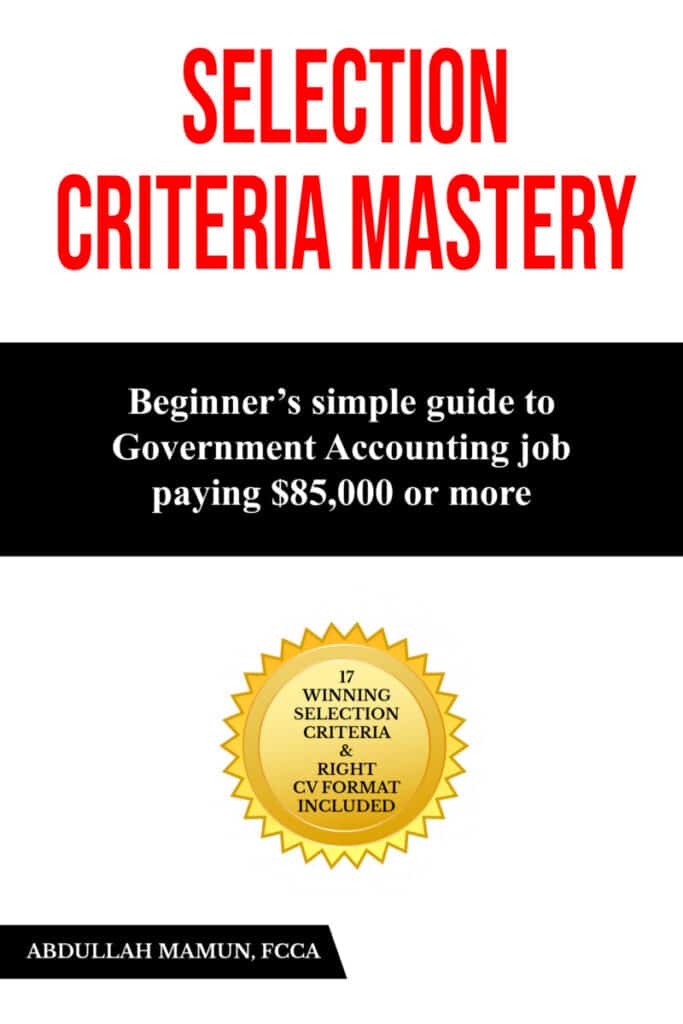The secret weapon they DON’T tell you about in government job applications (hint: it’s not your resume). Many prospective candidates lose the amazing opportunity just because they don’t know how to write selection criteria. Even the existing government employees don’t get promoted simply because they don’t know how to write a selection criteria response.
From my experiences, you will face lots of problems to respond correctly the selection criteria. I personally faced difficulties writing the selection criteria.
The problem is understanding the language: Government selection criteria often use complex language and unfamiliar jargon, making it difficult for candidates to decipher the exact skills and qualities they’re looking for.
Grasping the nuances of specific verbs like “demonstrate,” “analyze,” or “contribute” can be challenging, leading to misinterpretations and misaligned responses.
Differentiating essential and desirable criteria: Not knowing which criteria are crucial for securing an interview versus those that are simply bonus points can lead to wasting time and effort on less impactful responses.
For anyone sights on landing a government job Down, breezing through the selection criteria might feel a touch bewildering. Fear not, mate! By the end of this guide, you’ll be chock-full of know-how on comprehending, responding, and acing these tricky guidelines. After reading this article you will be confident how to address the selection criteria and get the job. Guaranteed!
So, grab a cuppa and let’s dive in!
1) Understanding the Role and selection criteria response requirements
Selection criteria are essentially the skill sets, experiences and attributes the APS (Australian Public Service) is on the lookout for in its prospective employees. Think of it as your personal brief from the get-go, telling you exactly what they want in an ideal employee- handy, right? It’s not just a random string of buzzwords to sprinkle into your CV – addressing the selection criteria professionally can quite literally determine your spot in the running.
Find out Essential vs Desirable Criteria
Diving deeper, selection criteria fall into two buckets: essential and desirable. As the terms suggest, essential criteria are the non-negotiable skills or traits necessary for the job. It’s like the flour in a cake recipe—if you want to bake, you’ve got to have it.
Desirable criteria, on the other hand, are like the icing on the cake. They are attributes that would be great to have but aren’t deal-breakers. Not meeting all desirable criteria doesn’t mean you’re out of the race, so don’t hit the panic button just yet!
Common Types of Criteria Encountered
Expect to routinely encounter criteria about communication, teamwork, problem-solving, and other behavioral skills. They’re typically broad, yet pivotal, skills that keep the wheels of the public service machine well-oiled and speeding along.

2) Decoding the Language
Tips for Understanding Wording and Keywords
One rule of thumb with selection criteria lingo is to look out for action verbs like ‘demonstrate’, ‘apply’, or ‘manage’. These words set the stage for what they want you to do and how they want you to show it. Imagine them as your roadmap for crafting killer responses. These words basically want you to clearly explain how you would do the job.
Strategies for Identifying Key Verbs and Desired Skills
Circle those action verbs and make them your heroes when structuring your responses. Similarly, keep a keen eye for desired skills embedded within the criteria. If a criterion asks for ‘excellent written communication’, make sure to highlight your wordsmith wizardry.
Tailoring Responses to Each Criterion
Remember this golden rule of thumb: Don’t use a one-size-fits-all approach. Tailoring is key. Your responses should be as bespoke as a Saville Row suit, highlighting how your skills and experiences squarely meet each criterion.
3) Crafting Winning Responses
Now we get to the meat and potatoes—how to pen responses that knock socks off!
Introducing the STAR Method
Apropos crafting responses, let me introduce you to your new best friend – the STAR method. This bowler hat comes packed with ‘Situation’, ‘Task’, ‘Action’, and ‘Result’. It’s a storyteller’s dream!
Structuring a Strong STAR Response
Let’s play it out. Begin by describing the Situation, putting context to your story. Then, elaborate on the Task that was at hand. Follow it up with the Action you took—really zoom into your role and contribution. And then, the grand finale, the Result achieved.
Remember, your STAR responses must paint a vivid picture and deliver concrete evidence of your skills and experiences.
Examples of Well-structured Responses
Let’s say the criterion asks you to demonstrate teamwork. A strong STAR response might go like:
“When I was a project coordinator at ABC Corp (Situation), we encountered a significant hiccup right before a crucial product rollout (Task). As a solution, I proposed a series of intensive brainstorming sessions and coordinated with different team members for speedy execution (Action). The result was a successfully conducted roll-out, two days ahead of the scheduled timeline (Result).”
See how that panned out? It wasn’t as scary as it seemed, right?
4) Common Pitfalls and Tips
Common Mistakes Made
Failing to give concrete examples or being overly verbose are just a couple of the many pitfalls candidates face while responding. My advice, keep it succinct yet impactful.
Avoiding Jargon and Demonstrating Impact
Replace jargon with plain English to make your response easily understandable. And remember, always, always emphasize your individual impact in team initiatives. It’s your job application, not your team’s!
Additional Tips
Proofread your answers with the precision of a hawk scanning for prey. Practice your responses out loud—trust me, it helps. And do solicit feedback from others for a fresh perspective.
5) Beyond the Guide
Additional Resources
The internet is packed with treasures like online tools, preparation workshops, and government websites to help understand and aptly answer selection criteria. Use them!
Researching the Specific Agency and Role
Get your superspy glasses on and research not just the specific role, but also the agency you’re applying for. Understanding their mission, values, and work culture can offer invaluable insights and position your application favorably.
Tailoring Resumes and Cover Letters
In the same vein as tailoring responses, shape your resume and cover letter to align with the selection criteria—it’s all one neat package, after all.
Conclusion
There you have it, everything you’ve ever needed to know about selection criteria for Australian Government jobs, wrapped into one nifty guide.
Remember, take the selection criteria seriously, it’s your ticket to visibility in the ocean of applications. Understand the criteria, tailor your responses and showcase your skills and experiences in the best possible light.
Now, go on, crack on! Sharpen those quills, flex those grey cells, and hoist the sails. Your dream government job awaits!
If you need further help, check out this book on amazon.
Bonus:
Here, I am sharing a real example of selection criteria that won the job.
Job Advert:
This role supports the efficient functions of the financial operations of the department through the provision of day-to-day accounting services.
Key Questions were:
- Ability to Manage and prioritise tasks
- Excellent use of Microsoft skills.
Now see the responses:
Ability to manage, prioritise and adapt: In my previous role, I was part of the team to change from traditional HR systems to Aurion Payroll System for greater efficiency and better employee experience. However, after the software implementation, we noticed that this software was not calculating payroll accrual data correctly. It needed human intervention. I then supported HR with our payroll data and manual calculation. First few months, this accrual data was calculated and uploaded manually to the system. To implement this new work features, I had to change my work priorities. I was maintaining excel files to calculate employee liabilities and reconciling with the system data. After each fortnight, I had to support HR with the manual payroll data calculation. To manage this, I took the initiative to lead team training sessions on the new technology and collaborated with stakeholders to ensure a smooth transition. Ultimately, this new system worked out smoothly.
Excellent Microsoft Excel: In my previous roles, I applied advanced proficiency in Microsoft Excel, leveraging its features for data analysis, complex calculations, and creating detailed reports. I am an advanced user of Microsoft office package. I have used excel VLOOK up, Pivot table, SUMIF functions and others to summarise the data and prepare meaningful reports. In several occasions, I improved the excel files with better linking of tabs, formulas etc. While preparing the draft annual financial statement, I noticed that different files were used to prepare notes in Excel. Then, I recreated one file with all the relevant tabs linked to the main file. This saved time and data was much more accurate. It also provided flexibility to edit. I have also used Microsoft word to create the monthly reports. I am very skilled in editing word documents while putting tables, graphs etc. I confidently used Microsoft office applications to manage day to day activities.
So, now you know how to respond to a selection criterion. Order this book, then you will get more in-depth knowledge. Plus, you will get in depth knowledge of CV formatting, responses writing formats.

